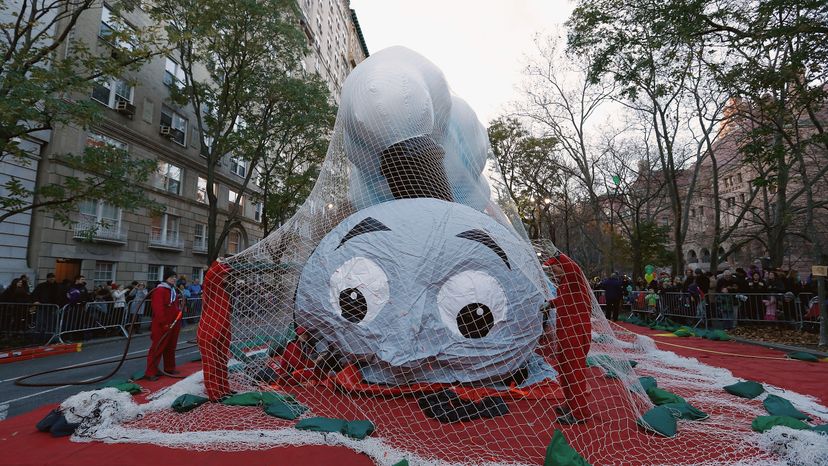Macy's Parade Balloons

Balloons were introduced in 1927, three years after the inaugural parade, and featured cartoon animal characters to replace the live zoo animals. Initially, the balloons were air-filled and carried by string. Later, a mixture of low-density helium and air was used. This enabled parade designers to create large-proportion balloons like a 50-foot-tall (15-meter) hummingbird.
Today, in a former Tootsie Roll factory in Hoboken, New Jersey, just across the river from New York City, the balloons are created by the Macy's Parade Studio. Depending on what's being depicted, a figure may be fashioned vertically, horizontally or somewhere in between.
Advertisement
It all starts with a pencil sketch. Aerodynamic and engineering consultants assist with calculations to make sure the balloon will fly properly. An exact-scale replica made out of clay and a painted model (also an exact-scale replica) are fashioned before the actual balloon is cut out of fabric. Each balloon has several chambers and includes a zipper, an inflation device and a high-pressure valve. Flight, inflation and deflation tests are run, and cosmetic adjustments are made. Finally, the balloon can appear in the parade, up to one year after the process began.
Balloons are constructed of polyurethane, though they used to be made of rubber. Since the switch from air to helium, the behemoth balloons have coasted along with a big dose of help from volunteer balloon wranglers. But it hasn't always been that easy to keep the balloons afloat. In 1958, the balloons were filled with air and hoisted by cranes onto trucks due to a helium shortage. Poor weather conditions kept the balloons from being inflated at all in 1971.
The balloons' dimensions vary, but most are about five to six stories high and somewhere around 60 feet (18 meters) long and 30 feet (9 meters) wide. Each balloon needs around 90 handlers. In all, there are around 2,000 to 3,000 balloon handlers.
These handlers must weigh at least 120 pounds (54 kilograms) and be in good health. Of those, only a few hundred team leaders are required to attend training, though all are invited. Training includes lessons on aerodynamics, geometry and physics. Then, volunteers practice handling one of the big balloons on a field. The team leaders include an overall leader, pilot, captain and two drivers. A police officer marches with each balloon. The handlers dress in outfits that coordinate with their balloon and hold the ropes to guide the balloon. Each balloon is also tethered to two 800-pound (363-kilogram) utility vehicles.
In recent years, balloon accidents have made news, but there were other balloon bumps over the years. A Mighty Mouse balloon collapsed due to strong winds in 1956. Rain drenched the Kermit the Frog balloon in 1985, and he had to be carried. The Sonic the Hedgehog balloon injured an off-duty police captain in 1993. More recently, in 1997, a woman was in a coma for nearly a month after the Cat in the Hat balloon careened into a lamppost, raining debris on spectators. In 2005, an M&M balloon injured two sisters when it hit a street lamp and part of it crashed into them.
Of course, true "balloonatics" — ardent fans of the parade — aren't dissuaded by such rare occurrences. But as you'll find out later, the city of New York takes these accidents seriously and has put guidelines in place to make balloon wranglers and spectators more safe.